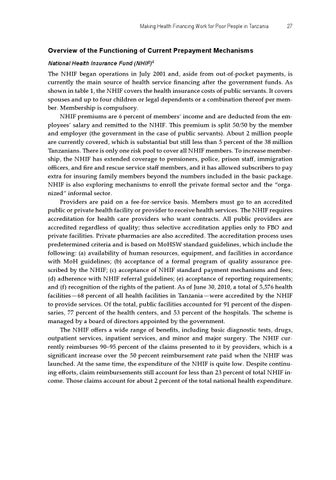Making Health Financing Work for Poor People in Tanzania
27
Overview of the Functioning of Current Prepayment Mechanisms National Health Insurance Fund (NHIF)4
The NHIF began operations in July 2001 and, aside from out-of-pocket payments, is currently the main source of health service financing after the government funds. As shown in table 1, the NHIF covers the health insurance costs of public servants. It covers spouses and up to four children or legal dependents or a combination thereof per member. Membership is compulsory. NHIF premiums are 6 percent of members’ income and are deducted from the employees’ salary and remitted to the NHIF. This premium is split 50/50 by the member and employer (the government in the case of public servants). About 2 million people are currently covered, which is substantial but still less than 5 percent of the 38 million Tanzanians. There is only one risk pool to cover all NHIF members. To increase membership, the NHIF has extended coverage to pensioners, police, prison staff, immigration officers, and fire and rescue service staff members, and it has allowed subscribers to pay extra for insuring family members beyond the numbers included in the basic package. NHIF is also exploring mechanisms to enroll the private formal sector and the “organized” informal sector. Providers are paid on a fee-for-service basis. Members must go to an accredited public or private health facility or provider to receive health services. The NHIF requires accreditation for health care providers who want contracts. All public providers are accredited regardless of quality; thus selective accreditation applies only to FBO and private facilities. Private pharmacies are also accredited. The accreditation process uses predetermined criteria and is based on MoHSW standard guidelines, which include the following: (a) availability of human resources, equipment, and facilities in accordance with MoH guidelines; (b) acceptance of a formal program of quality assurance prescribed by the NHIF; (c) acceptance of NHIF standard payment mechanisms and fees; (d) adherence with NHIF referral guidelines; (e) acceptance of reporting requirements; and (f) recognition of the rights of the patient. As of June 30, 2010, a total of 5,576 health facilities—68 percent of all health facilities in Tanzania—were accredited by the NHIF to provide services. Of the total, public facilities accounted for 91 percent of the dispensaries, 77 percent of the health centers, and 53 percent of the hospitals. The scheme is managed by a board of directors appointed by the government. The NHIF offers a wide range of benefits, including basic diagnostic tests, drugs, outpatient services, inpatient services, and minor and major surgery. The NHIF currently reimburses 90–95 percent of the claims presented to it by providers, which is a significant increase over the 50 percent reimbursement rate paid when the NHIF was launched. At the same time, the expenditure of the NHIF is quite low. Despite continuing efforts, claim reimbursements still account for less than 23 percent of total NHIF income. Those claims account for about 2 percent of the total national health expenditure.
